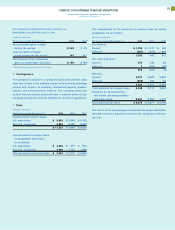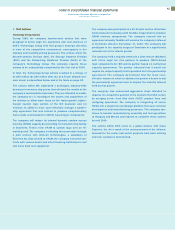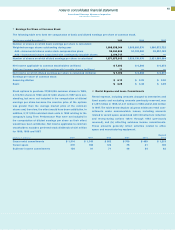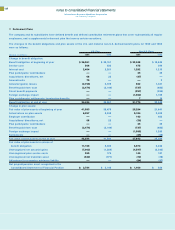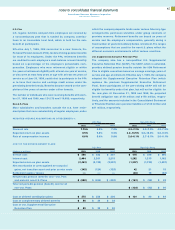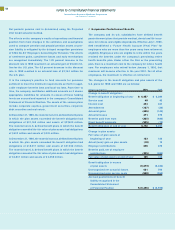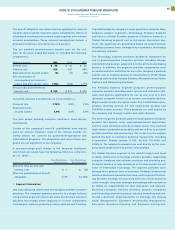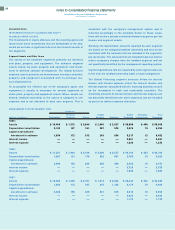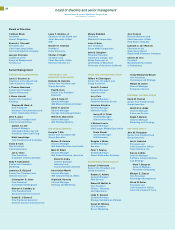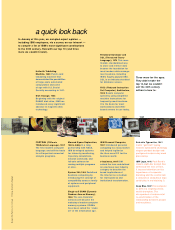IBM 1999 Annual Report Download - page 91
Download and view the complete annual report
Please find page 91 of the 1999 IBM annual report below. You can navigate through the pages in the report by either clicking on the pages listed below, or by using the keyword search tool below to find specific information within the annual report.
notes to consolidated financial statements
International Business Machines Corporation
and Subsidiary Companies
The benefit obligation was determined by applying the terms of
medical, dental and life insurance plans, including the effects of
established maximums on covered costs, together with relevant
actuarial assumptions. These actuarial assumptions include a
projected healthcare cost trend rate of 6 percent.
The net periodic postretirement benefit cost for the U.S.
plan for the years ended December 31 included the following
components:
(Dollars in millions) 1999 1998 1997
Service cost $«««48 $«««42 $«««32
Interest cost 424 427 455
Expected return on plan assets (6) (5) (15)
Net amortization of
unrecognized net actuarial
losses and prior service costs (124) (133) (119)
Net periodic postretirement
benefit cost $«342 $«331 $«353
WEIGHTED-AVERAGE ASSUMPTIONS AS OF DECEMBER 31:
Discount rate 7.75% 6.5% 7.0%
Expected return
on plan assets 5.0% 5.0% 5.0%
The plan assets primarily comprise short-term fixed income
investments.
Certain of the company’s non-U.S. subsidiaries have similar
plans for retirees. However, most of the retirees outside the
United States are covered by government-sponsored and
administered programs. The obligations and cost of these pro-
grams are not significant to the company.
A one-percentage-point change in the assumed healthcare
cost trend rate would have the following effects as of Decem-
ber 31, 1999:
One-Percentage- One-Percentage-
(Dollars in millions) Point Increase Point Decrease
Effect on total service and
interest cost $«««7 $«««««(9))
Effect on postretirement benefit
obligation $«95 $«(120)
Y Segment Information
IBM uses advanced information technology to provide customer
solutions. The company operates primarily in a single industry
using several segments that create value by offering a variety of
solutions that include, either singularly or in some combination,
technologies, systems, products, services, software and financing.
Organizationally, the company’s major operations comprise three
hardware product segments—Technology, Personal Systems
and Server; a Global Services segment; a Software segment; a
Global Financing segment and an Enterprise Investment seg-
ment. The segments are determined based on several factors,
including customer base, homogeneity of products, technology
and delivery channels.
The Technology segment produces peripheral equipment for
use in general-purpose computer systems, including storage
and networking devices, advanced function printers and display
devices. In addition, the segment provides components such
as semiconductors and HDDs for use in the company’s products
and for sale to original equipment manufacturers (OEM). Major
business units include Storage Systems, Microelectronics, Printer
Systems and Networking Hardware.
The Personal Systems segment produces general-purpose
computer systems, including some system and consumer soft-
ware, that operate applications for use by one user at a time
(personal computer clients) or as servers, and display devices.
Major brands include the Aptiva home
PC
s, IntelliStation work-
stations, Netfinity servers,
PC
300 commercial desktop and
ThinkPad mobile systems. These products are sold directly by
the company and through reseller and retail channels.
The Server segment produces powerful multi-purpose computer
systems that operate many open-network-based applications
and are used simultaneously by multiple users. They perform
high-volume transaction processing and serve data to personal
systems and other end-user devices. The servers are the engines
behind the bulk of electronic business transactions, including
e-commerce. Brands include S/ 390, AS/ 400, RS/ 6000 and
NUMA-Q. The segment’s products are sold directly by the com-
pany and through business partner relationships.
The Global Services segment is the world’s largest and most
versatile information technology services provider, supporting
computer hardware and software products and providing pro-
fessional services to help customers of all sizes realize the full
value of information technology. The segment provides value
through three primary lines of business: Strategic Outsourcing
Services; Business Innovation Services; and Integrated Technol-
ogy Services. Strategic Outsourcing Services create business
value through long-term strategic partnerships with customers
by taking on responsibility for their processes and systems.
Business Innovation Services (formerly Systems Integration
and Consulting) provide business/ industry consulting and end-
to-end e-business implementation of offerings like Supply
Chain Management, Customer Relationship Management,
Enterprise Resource Planning and Business Intelligence.
89


